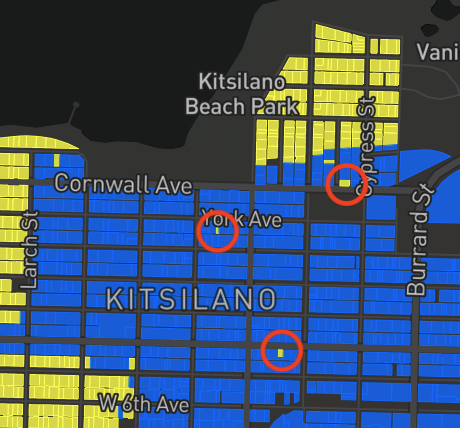The essence of --coalesce-smallest-as-needed is to merge together features that shouldn't legitimately be merged based on their attributes, but must be merged to make the tiles small enough. It prioritizes geometric completeness over attribute correctness.
If you want to coalesce only those features that really ought to be coalesced because they have identical attributes, please use --coalesce instead. (But that may not be sufficient if there are not enough features with identical attributes.)
Or do I misunderstand the issue?


Hi,
I'm using Tippecanoe on a set of polygons and am running into what might be a bug in the
coalesce-smallest-as-neededoption. It seems to put a small number of polygons in the wrong place at lower zoom levels. Apologies if I'm misunderstanding how the feature works, and please let me know if I can do anything else to help identify/reproduce the issue.Details
I have a set of polygons (~100k) that represents all of the properties in a city. I'm trying to perform some simple visualization using Mapbox GL JS (all properties zoned like this vs. all properties zoned like that).
If I run Tippecanoe with
-f -z 15 -Z 8 -l default -Bgit turns out like this. Not bad, but I'd like to maintain the original area covered by the polygons even when viewing the entire city.Next I ran Tippecanoe with
-f -z 15 -Z 8 -l default -Bg --coalesce-smallest-as-needed --maximum-tile-bytes=250000and this is how it turned out. It looks much better but now some of the polygons are in the wrong location at lower zoom levels.I'm using
--maximum-tile-bytes=250000for demonstration purposes, the problem is still present with 500k tiles but a bit less obvious.Examples
These are all from my map at https://stoic-rosalind-23887f.netlify.com which uses a Mapbox-hosted .mbtiles file. I created the tiles by running Tippecanoe with
-f -z 15 -Z 8 -l default -Bg --coalesce-smallest-as-needed --maximum-tile-bytes=250000See the bottom left of the map at zoom level 12:
And at zoom level 13:
Note the polygon that changed from yellow to blue. If I click on that tile to get more info at zoom level 12, I can tell that 1) it's a polygon that should be yellow according to its features, 2) it's definitely in the wrong place. This image shows where the yellow polygon is vs. where it should be (and is located at higher zoom levels):
This occurs elsewhere in the city too:
Note the yellow tiles (surrounded by blue) which disappear as we zoom in.